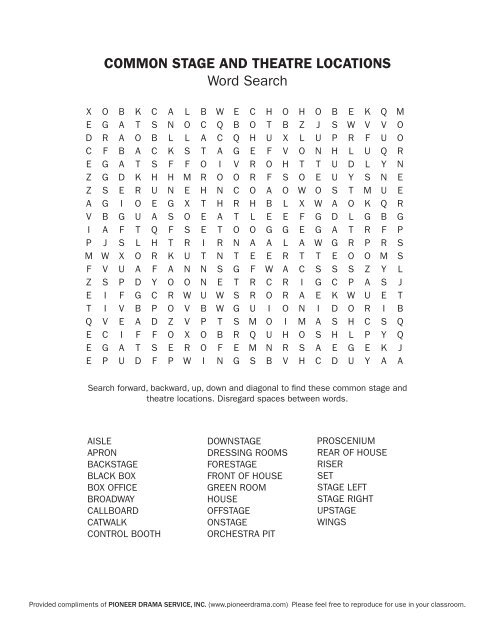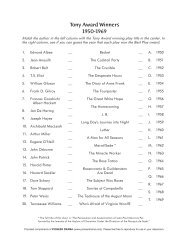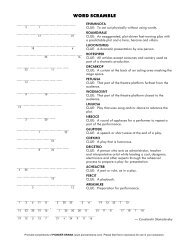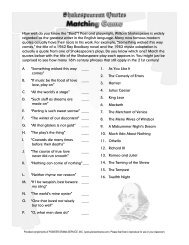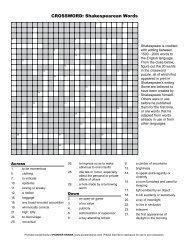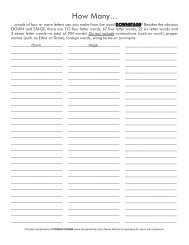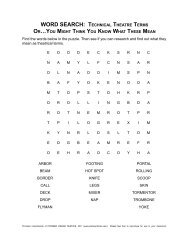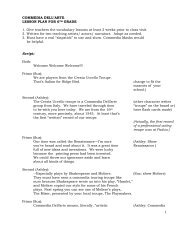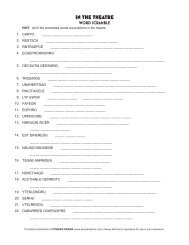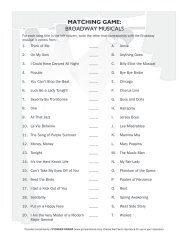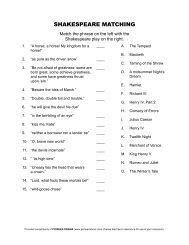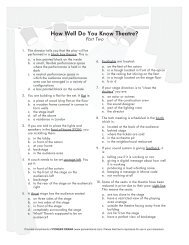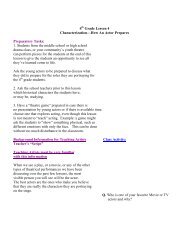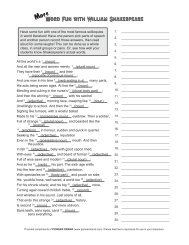COMMON STAGE AND THEATRE LOCATIONS Word Search
COMMON STAGE AND THEATRE LOCATIONS Word Search
COMMON STAGE AND THEATRE LOCATIONS Word Search
You also want an ePaper? Increase the reach of your titles
YUMPU automatically turns print PDFs into web optimized ePapers that Google loves.
<strong>COMMON</strong> <strong>STAGE</strong> <strong>AND</strong> <strong>THEATRE</strong> <strong>LOCATIONS</strong><br />
<strong>Word</strong> <strong>Search</strong><br />
X O B K C A L B W E C H O H O B E K Q M<br />
E G A T S N O C Q B O T B Z J S W V V O<br />
D R A O B L L A C Q H U X L U P R F U O<br />
C F B A C K S T A G E F V O N H L U Q R<br />
E G A T S F F O I V R O H T T U D L Y N<br />
Z G D K H H M R O O R F S O E U Y S N E<br />
Z S E R U N E H N C O A O W O S T M U E<br />
A G I O E G X T H R H B L X W A O K Q R<br />
V B G U A S O E A T L E E F G D L G B G<br />
I A F T Q F S E T O O G G E G A T R F P<br />
P J S L H T R I R N A A L A W G R P R S<br />
M W X O R K U T N T E E R T T E O O M S<br />
F V U A F A N N S G F W A C S S S Z Y L<br />
Z S P D Y O O N E T R C R I G C P A S J<br />
E I F G C R W U W S R O R A E K W U E T<br />
T I V B P O V B W G U I O N I D O R I B<br />
Q V E A D Z V P T S M O I M A S H C S Q<br />
E C I F F O X O B R Q U H O S H L P Y Q<br />
E G A T S E R O F E M N R S A E G E K J<br />
E P U D F P W I N G S B V H C D U Y A A<br />
<strong>Search</strong> forward, backward, up, down and diagonal to find these common stage and<br />
theatre locations. Disregard spaces between words.<br />
AISLE<br />
APRON<br />
BACK<strong>STAGE</strong><br />
BLACK BOX<br />
BOX OFFICE<br />
BROADWAY<br />
CALLBOARD<br />
CATWALK<br />
CONTROL BOOTH<br />
DOWN<strong>STAGE</strong><br />
DRESSING ROOMS<br />
FORE<strong>STAGE</strong><br />
FRONT OF HOUSE<br />
GREEN ROOM<br />
HOUSE<br />
OFF<strong>STAGE</strong><br />
ON<strong>STAGE</strong><br />
ORCHESTRA PIT<br />
PROSCENIUM<br />
REAR OF HOUSE<br />
RISER<br />
SET<br />
<strong>STAGE</strong> LEFT<br />
<strong>STAGE</strong> RIGHT<br />
UP<strong>STAGE</strong><br />
WINGS<br />
Provided compliments of PIONEER DRAMA SERVICE, INC. (www.pioneerdrama.com) Please feel free to reproduce for use in your classroom.
<strong>COMMON</strong> <strong>STAGE</strong> <strong>AND</strong> <strong>THEATRE</strong> <strong>LOCATIONS</strong><br />
Glossary and <strong>Word</strong> <strong>Search</strong> Answer Key<br />
AISLE—Area of passage between seating areas.<br />
APRON—The portion of a proscenium stage that falls<br />
between the main curtain and the audience. At times<br />
apron scenes are played either to indicate a different<br />
setting or to cover for a scenery change behind the<br />
main curtain. Sometimes the orchestra pit is raised<br />
or covered to create a larger apron or forestage.<br />
BACK<strong>STAGE</strong> —Those parts of the theatre behind the<br />
stage, including dressing rooms.<br />
BLACK BOX—A neutral performance space with black<br />
walls, floor and ceiling, in which the audience and performance<br />
area can be arranged in a variety of configurations.<br />
This differs from the traditional proscenium<br />
stage, which has permanent seating, a raised stage,<br />
an orchestra pit and wings. The black box theatre is<br />
ideal for low-budget, experimental or non-traditional<br />
plays, usually employing minimal scenery and seating<br />
fewer than 100 people.<br />
BOX OFFICE —The enclosed area in the outer lobby of a<br />
theatre where tickets are sold.<br />
BROADWAY—The New York City theatrical district.<br />
CALLBOARD —A bulletin board found backstage for pertinent<br />
announcements to the actors and technicians.<br />
CATWALK —A narrow walkway above the stage to allow<br />
technicians to work lines, lighting and scenery.<br />
CONTROL BOOTH —The small isolated room in which the<br />
electrician and/or sound technician sits to operate<br />
the lights, sound and other effects, usually located<br />
in the rear of the theatre. Also called sound booth,<br />
projection booth.<br />
DOWN<strong>STAGE</strong> —Toward the apron or audience. The early<br />
theatres actually had a sloping or raked stage, and<br />
that part nearer the audience was lower than the<br />
other end. This allowed the audience, seated on a<br />
flat plane, to see better.<br />
DRESSING ROOMS—Rooms for actors to change costumes<br />
and apply makeup.<br />
FORE<strong>STAGE</strong> —(See APRON.)<br />
FRONT OF HOUSE —This refers to the auditorium and<br />
the lobby as opposed to the stage area. For example,<br />
ushers work in “the front of the house.”<br />
GREEN ROOM—Traditionally, a waiting room where performers<br />
rest or receive visitors.<br />
HOUSE —The audience or the theatre itself. For example,<br />
“We had a full house.” or “The house didn’t respond<br />
well.”<br />
OFF<strong>STAGE</strong>—Refers to the area beyond the stage setting,<br />
out of view of the audience.<br />
ON<strong>STAGE</strong>—As it implies, on the stage.<br />
ORCHESTRA PIT —Space for musicians located directly in<br />
front of the stage. In some theatres, it is sunken so<br />
that the audience can view the show without seeing<br />
the musicians. If musicians are not present, sometimes<br />
the floor of the pit is raised to create a larger<br />
forestage.<br />
PROSCENIUM —The open frame in the solid wall of the<br />
auditorium that encloses the stage and separates it<br />
from the audience. The proscenium arch rises like a<br />
giant picture frame surrounding the playing area.<br />
REAR OF HOUSE—The areas in the back of the stage.<br />
RISER —Stage platform. Also refers to the narrow, steplike<br />
platforms on which a choir stands.<br />
SET —The time and place in which the action of a play<br />
occurs.<br />
<strong>STAGE</strong> LEFT —As an actor stands facing the audience,<br />
stage left is on the left.<br />
<strong>STAGE</strong> RIGHT— As an actor stands facing the audience,<br />
stage right is on the right.<br />
UP<strong>STAGE</strong> —(1) That part of the stage furthest from the<br />
audience. (2) To walk upstage of another actor, forcing<br />
the other cast member to turn his or her back to<br />
the audience. (3) To draw the attention of the audience<br />
away from the featured performer. For example,<br />
“The jester upstaged the queen by gesturing and<br />
making faces at the audience behind her back.”<br />
WINGS —The offstage spaces at the sides of the set.<br />
X O B K C A L B . . . . . . . . E . . M<br />
E G A T S N O . . . . T . . . S . . . O<br />
D R A O B L L A C . H . . . U . . . . O<br />
. . B A C K S T A G E F . O . H . . . R<br />
E G A T S F F O I . R O H T T . . . . N<br />
. . D . . . . R . O R F . O E . . S . E<br />
. . . R . . E . N C O . O . . S T . . E<br />
. . . . E G . T H R . B . . . A . K . R<br />
. . . . A S O E A . L E E . G . L . . G<br />
. . . T . F S E . O . G G E . A . . . P<br />
. . S . H T R I R . A . L A W . R . R .<br />
. . . O R . . T N T . E . T T E . O . .<br />
. . U A . . N N S G F . A . S S S . Y .<br />
. S P . . O O N E T R C . I . C P A . .<br />
E I . . C R W . . S . O R A E . W U . .<br />
T . . . P O . . . . U . O N I D . . . .<br />
. . . A D . . . . . . O I M A S . . . .<br />
E C I F F O X O B . . U H O S . L . . .<br />
E G A T S E R O F . M . R . . . . E . .<br />
. . . . . . W I N G S B . . . . . . . .<br />
Provided compliments of PIONEER DRAMA SERVICE, INC. (www.pioneerdrama.com) Please feel free to reproduce for use in your classroom.


